
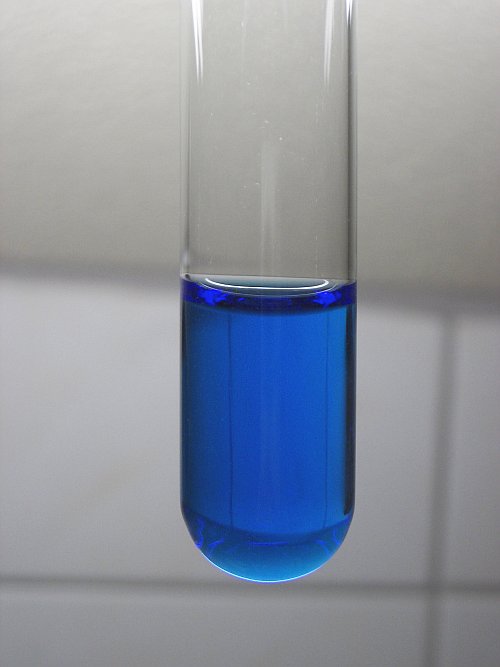

Aqueous solutions and precipitates of vanadium
In aqueous solutions, vanadium exists in the +2, +3, +4, and +5 oxidation states. Vanadium in the +2 and +3 oxidation states exists in aqueous solution as plain aqua ions V2+(aq) and V3+(aq). Vanadium in the oxidation states +4 and +5 exists as oxo-anions in alkaline solutions and as oxo-cations in acidic solution. Vanadium is one of the transition metals (together with chromium) with a remarkably rich and also remarkably colorful aqueous chemistry. Just to give an impression of the colorful chemistry, a picture is shown here with vanadium in all four oxidation states in acidic solution in the form of cations. From left to right, this picture shows the +2, +3, +4 and +5 oxidation states as lavender V2+(aq), green/gray V3+(aq), blue VO2+(aq) and yellow VO2+(aq).
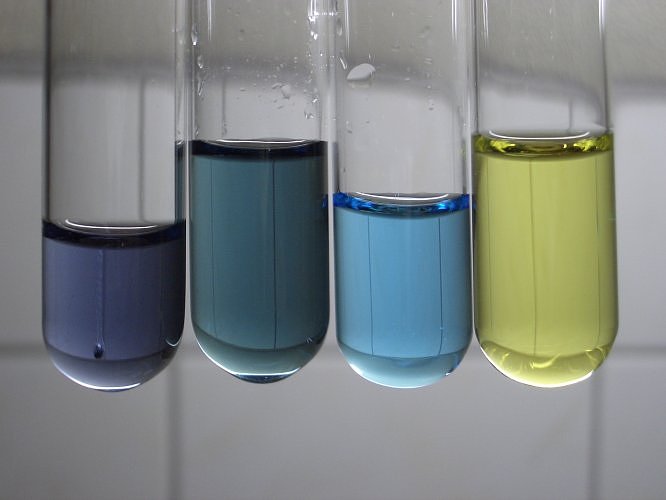
The +2 oxidation state is strongly reducing and very sensitive to aerial oxidation, both in acidic media and in alkaline media. The +3 oxidation state also is strongly reducing, but aqueous solutions are fairly stable, when the liquid is acidic.
Oxidation state +4 is the most stable oxidation state of vanadium. The aqueous chemistry of vanadium in its +5 oxidation state is remarkably complex and still not fully understood. Vanadium in the +5 oxidation state forms many polynuclear ionic species. Further below, an attempt is made to give an impression of the incredibly complex behavior of vanadium in the +5 oxidation state.
![]()
Oxidation state +2
This is a strongly reducing oxidation state of vanadium. In acidic and neutral media, the solution has a nice lavender color. This is due to the color of the V2+(aq) ion. When the solution is allowed to be in contact with air, it quickly turns green/blue, because of oxidation to the +3 oxidation state.
The hydroxide is even a stronger reductor, even capable of reducing water, producing hydrogen gas. When the lavender solution of a vanadium (II) salt is made alkaline, then a black precipitate V(OH)2 is formed. This precipitate quickly is oxidized by oxygen from the air to green V(OH)3 and this precipitate also is oxidized by water, to form vanadium (III) hydroxide and hydrogen gas. The right picture shows the bubbles of hydrogen. Click here for a more detailed picture of the formation of hydrogen gas. The right picture also shows that the black vanadium (II) hydroxide is quickly oxidized by oxygen to green vanadium (III) hydroxide. The solid, sticking to the glass has turned green already.
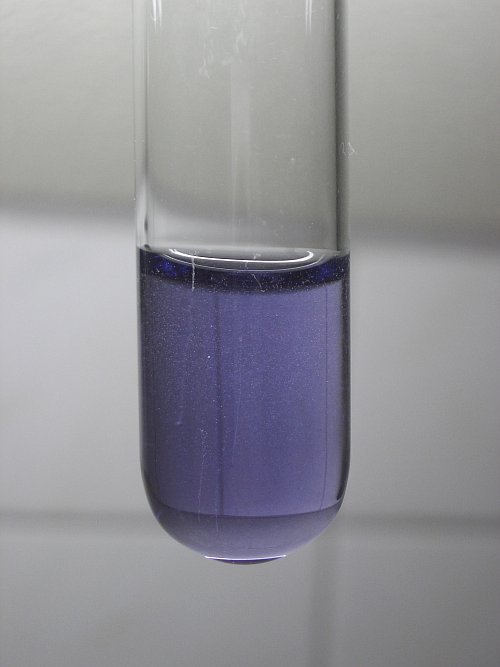
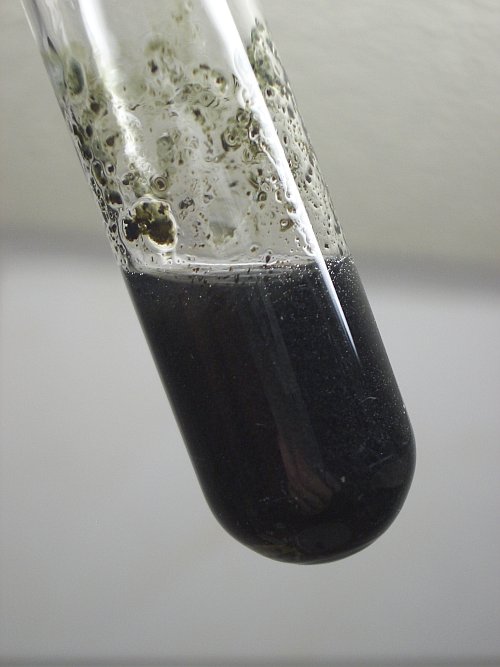
![]()
Oxidation state +3
Vanadium in the +3 oxidation still is a fairly strong reductor. An acidic or neutral solution of a vanadium (III) salt is oxidized by oxygen from the air very slowly. It takes many days before a solution, containing vanadium (III) ion is oxidized to a solution, containing vanadyl ion (vanadium in oxidation state +4, see below). The hydroxide, however, is more quickly oxidized by oxygen from the air. The hydroxide, however, is not capable of reducing water.
The four pictures below show
- a solution, containing aqueous vanadium (III), V3+(aq).
- a freshly prepared precipitate of vanadium (III) hydroxide, which looks dark dirty green.
- the freshly prepared precipitate of vanadium (III) hydroxide, when it is shaken. This precipitate has a dirty green color.
- a precipitate of vanadium (III) hydroxide, which is shaken for several minutes with contact with air. Part of the hydroxide is oxidized to a brown vanadium (IV) species.
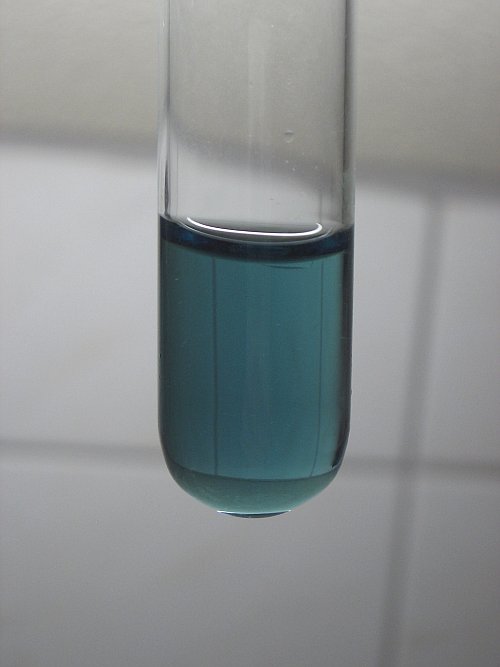
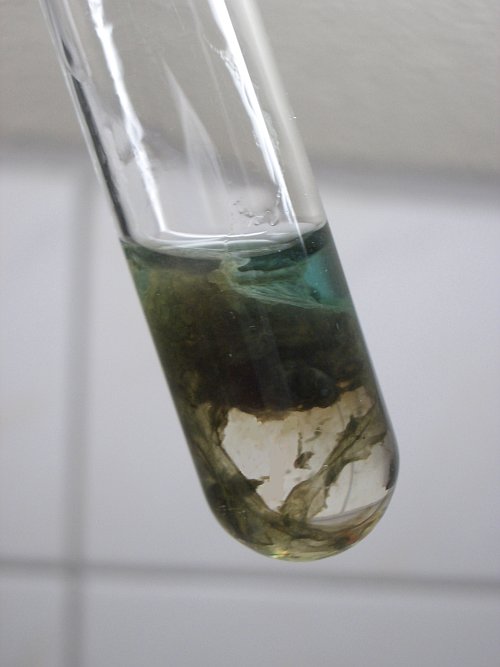
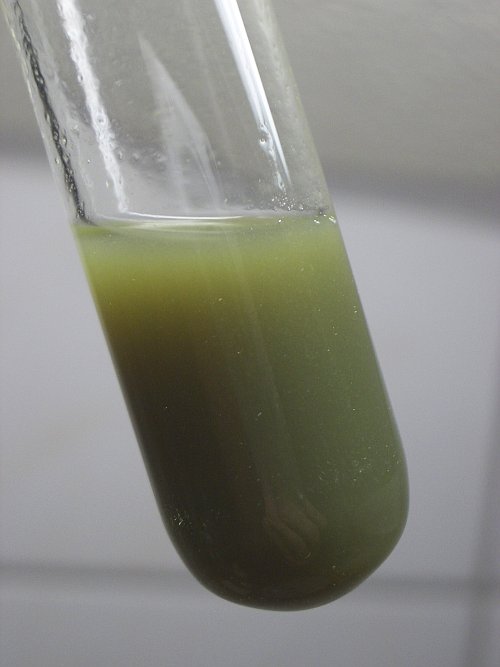
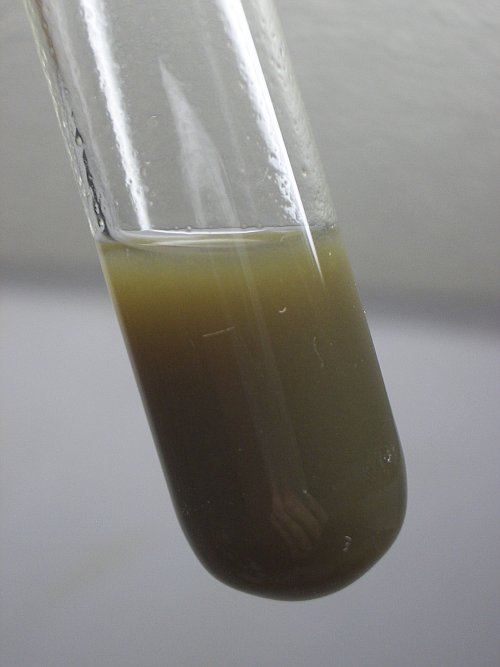
![]()
Oxidation state +4
As stated already, this is the most stable oxidation state. In acidic and neutral solutions, the species VO2+(aq) is present in solution. This is the blue vanadyl ion. When a carefully adjusted amount of hydroxide is added to such a solution, then a dark blue/black precipitate of hydrous VO(OH)2 is formed, which better can be represented as VO2·nH2O. Vanadium in the +4 oxidation state hardly has any basic properties anymore, it is amphoteric with a slight bias towards acidic. This can be shown nicely, when an excess amount of hydroxide is added to a solution containing the vanadyl ion. The liquid becomes clear again and a brown cation is formed. This brown cation is a species, containing multiple vanadium cores, connected by means of oxo-bridges and hydroxo-bridges. Below follow three pictures. The left shows vanadyl ions in slightly acidic solution, the middle one shows the hydrous precipitate of VO2 and the right shows the brown solution of the cationic vanadium (IV) species in excess solution of an alkali hydroxide. This brown species is a so-called polynuclear species, with properties, resembling vanadium in the +5 oxidation state, as described below. Its formula is V4O92-. This anion is dark brown/red. It sometimes is called hypovanadate.

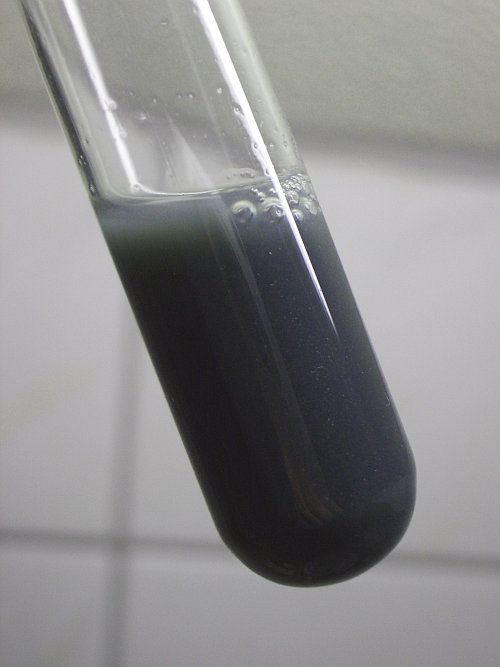
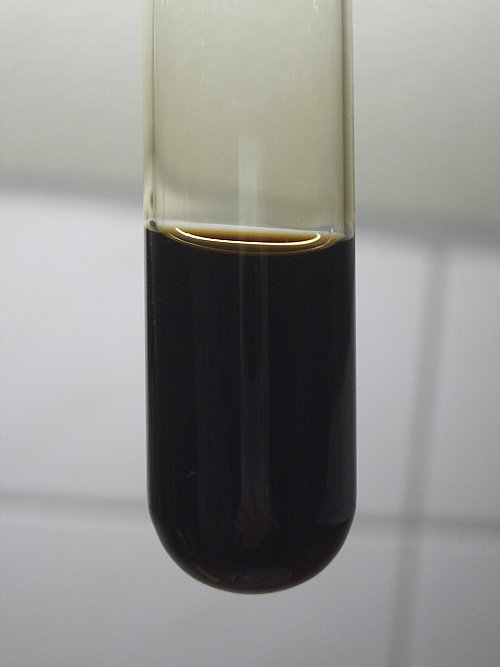
Below, a picture of the diluted liquid is shown, with a concentration, approximately 7 times as low. A nice red/brown and totally clear solution is obtained.
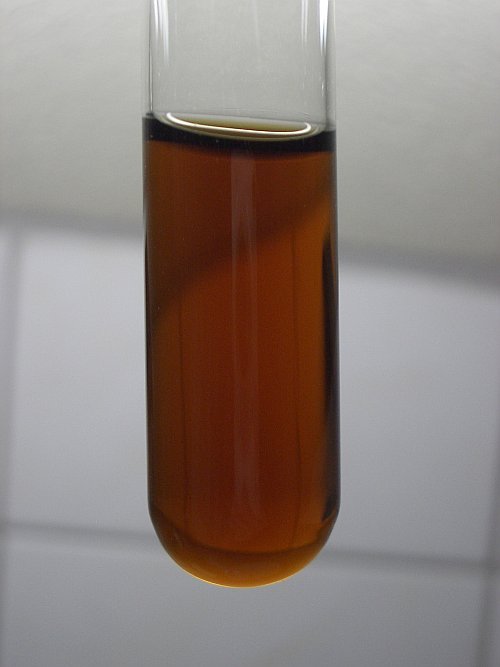
When one is experimenting with vanadium species in the +4 oxidation state in alkaline media, then it is very important to use distilled water. When tap water is used, then the brown species forms a precipitate, which is remarkably voluminous. Even a small amount of tap water gives a lot of precipitate. Probably, magnesium and calcium ions in tap water cause a large number of the brown cations to precipitate. The picture below shows the dark brown liquid (as shown above in the third, right-most picture), diluted approximately 5 times with tap water.
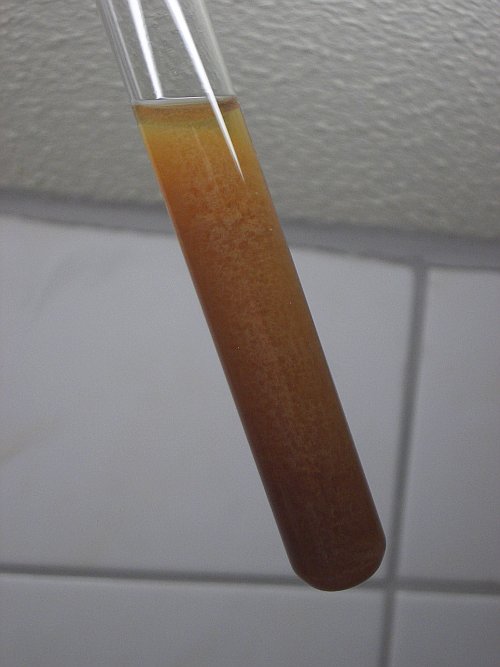
![]()
Oxidation state +5
This oxidation state is most remarkable. The behavior of vanadium in this oxidation state is very rich and still only partially understood. The behavior of vanadium in the +5 oxidation state is incredibly complex, as function of pH and as function of concentration. The pictures below reveal some of this remarkable behavior.
In the +5 oxidation state, one cannot simply say that vanadium forms certain anions or cations. The actual composition of a solution, containing vanadium in the +5 oxidation state strongly depends on pH.
At very high pH (somewhere above 14), vanadium forms colorless orthovanadate ions, VO43-(aq). When the pH is decreased, then the orthovanadate ions tend to be protonated, while splitting off water molecules.
At slightly lower pH, ions like VO3(OH)2-(aq) and VO2(OH)2–(aq) can be formed. These ions can split off water, forming metavanadate VO3–(aq).
When pH is still decreased further, then polymeric anionic species, containing multiple vanadium atoms, bridged by OH– groups and O2– groups are formed, with water molecules intercalated in the polynuclear structures.
Units, containing single vanadium atoms in the +5 oxidation state condense and form larger anions of general formula mVO2+·xO2-·yOH–·zH2O, with charge m - 2x - y < 0, and z water molecules intercalated in the anion. When pH is decreased, more and more of these anions condense to even larger anions, while at the same time more and more OH– groups and O2– groups are protonated. So, the net effect is increase of the size of anions, while the charge of a single anion does not increase at the same rate. The protonation of the OH– groups and O2– groups results in formation of water molecules, which are partly intercalated in the larger anion.
The larger the polymeric anions, the deeper the color. Anions with just a few vanadium atoms are colorless to pale yellow. When the number of vanadium atoms per anion increases, then the color goes to orange/red.
At a certain point (pH already well below 7, liquid quite acidic), the polymeric species can become so large, that macroscopic particles are formed. In this situation, m, x and y can be in the order of billions, while the total charge still is very close to 0. From a practical point of view, hence, the huge anion can be regarded as a neutral particle. This can be observed as an orange/red/brown precipitate. This precipitate can be regarded as V2O5·nH2O. This formula only is an empirical formula, the real structure of this precipitate is tremendously complex and it contains VO2+ groups, bridged by OH– groups, O2– groups and containing many intercalated H2O molecules.
At even lower pH, the OH– groups and O2– are further protonated, resulting in positively charged ions (m - 2x - y > 0) and breaking apart of the large polymeric species. Macroscopically this is observed as dissolving of the precipitate. At still decreasing pH, the breakdown of the large cations goes further, until finally at very low pH (somewhere below 0), single hydrated VO2+ groups exist in solution as light yellow cations.
The entire sequence, described above is shown by a fairly large set of pictures. The pictures start with a colorless and strongly alkaline solution, to which small amounts of acid are added, until a yellow strongly acidic liquid is obtained.
- The picture at the left shows a strongly alkaline liquid, containing anions with just one vanadium atom or maybe a few vanadium atoms.
- The middle picture shows this liquid, with just one drop of 10% HCl added. At the bottom, the colorless alkaline liquid can be seen, in the middle, there is a light yellow band with moderately condensed anionic species and at the top the condensed species are somewhat larger. This color is orange.
- The right picture shows what happens when some more 10% HCl is added. At the bottom, there still is the colorless alkaline liquid, which has a yellow layer of moderately condensed polyvanadate anions. The red band contains highly condensed polyvanadate species and this is close to precipitation. The lighter layer, above the red band is strongly acidic and this region contains cationic condensed poly-vanadium ions.
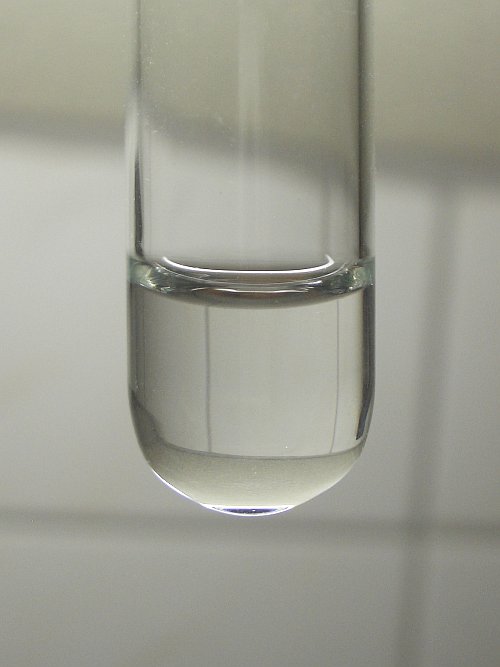
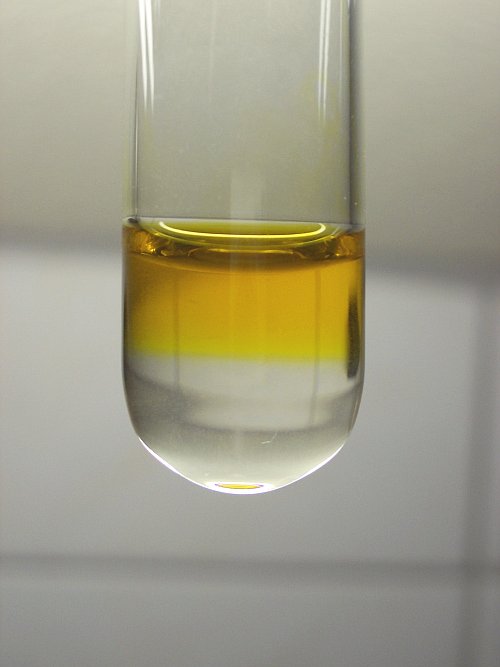
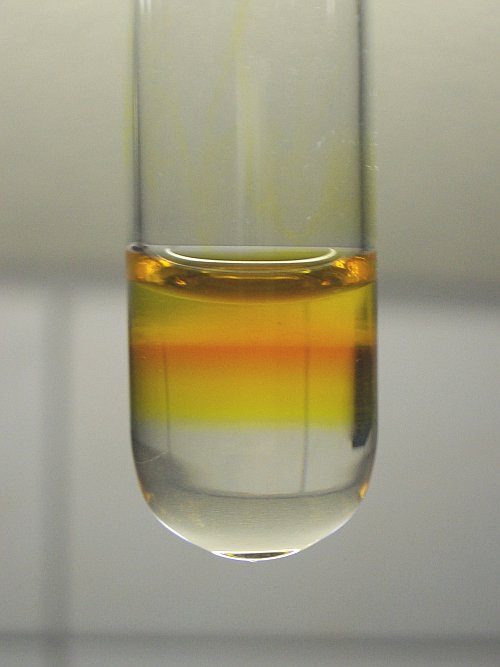
The two pictures below show what happens if even more 10% HCl is added. Now, the red layer turns into an area, where the condensation products become macroscopically large. This can be observed as an orange/red precipitate. Below this layer, there is an area of condensed polyvanadate anions and above this layer, there is an area of condensed poly-vanadium cations.
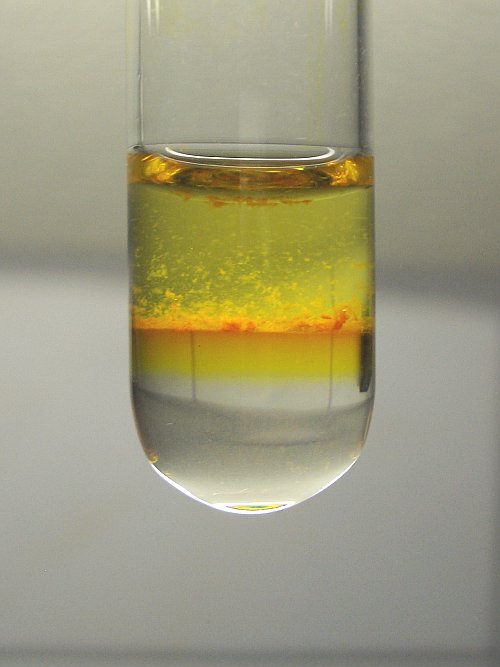
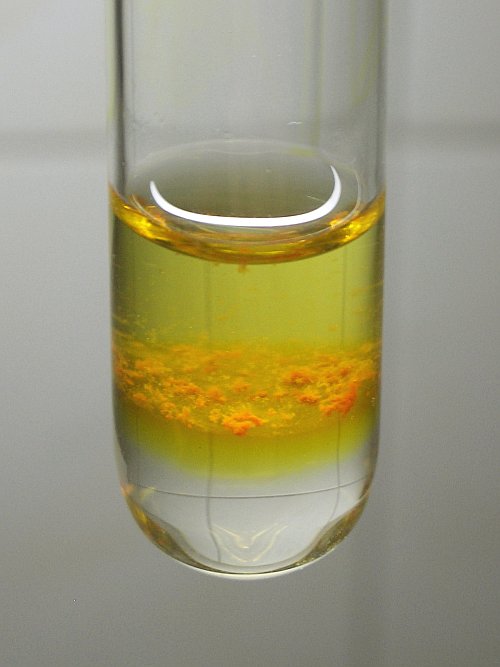
The two pictures below show what happens if the test tube is shaken somewhat. The excess acid in the top layer with cationic species is mixed up with the layer at the lower part of the test tube with anionic species. This causes the formation of an orange/red precipitate. On further shaking of the test tube, the liquid becomes clear again and deep orange. This orange color could be either due to large condensed anionic species, or due to large condensed cationic species. Anyway, this orange liquid is very close to the point where macroscopic particles are formed.
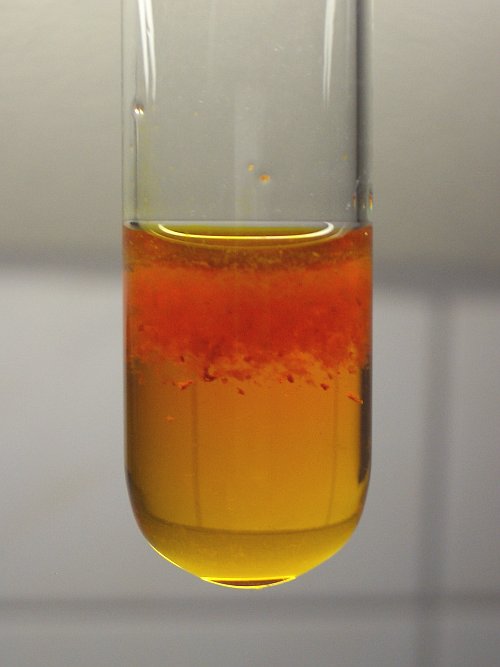
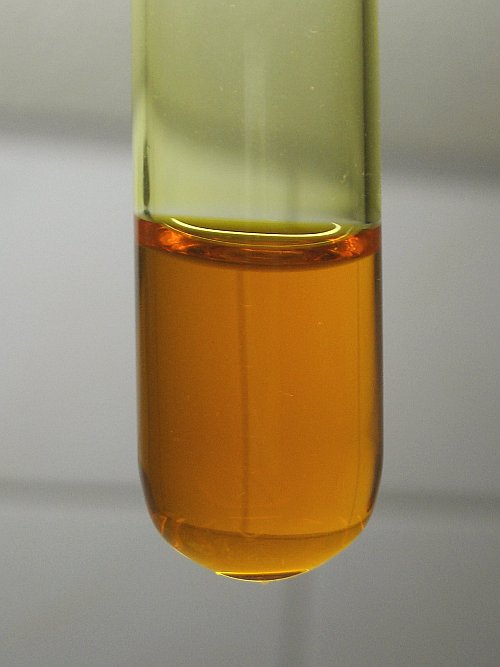
To the orange liquid a little more 10% HCl is added and when that is done, then the liquid becomes turbid fairly quickly and a bright orange/red precipitate is formed. So, from this, one can conclude that the orange liquid was still on the anionic side. When even more acid is added (some concentrated HCl), then the orange precipitate dissolves again, forming a yellow liquid. The right picture contains a strongly acidic liquid, with cationic vanadium ion, with only a low degree of condensation. Possibly, this liquid only contains the simple yellow cation VO2+(aq). This latter ion sometimes is called the pervanadyl ion.
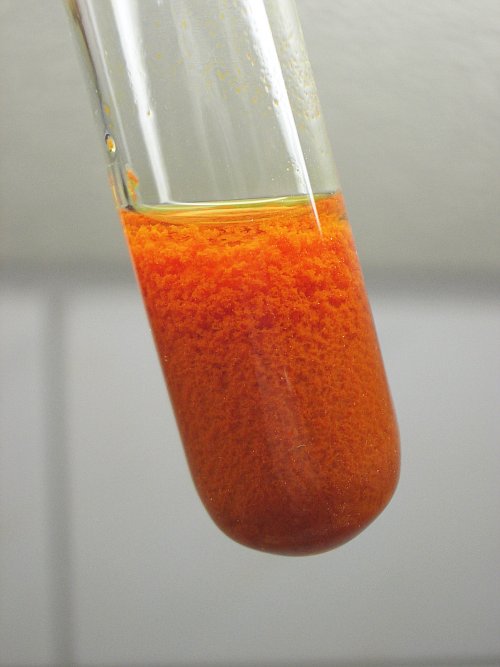
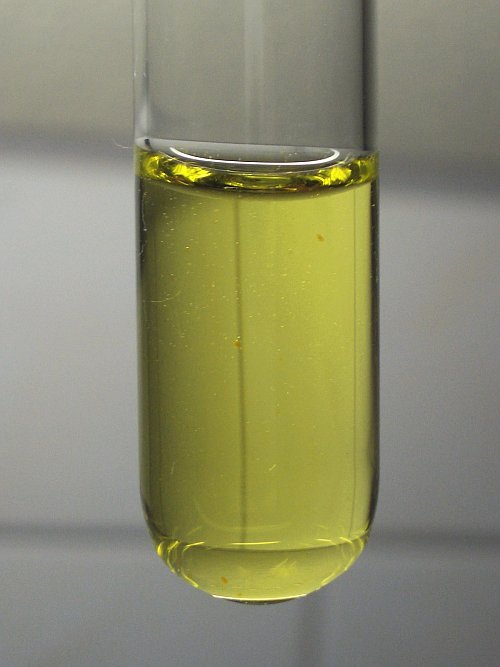
back to solutions/precipitates main page
back to miscellaneous main page